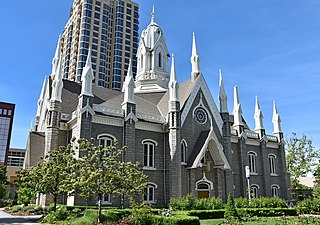
The Salt Lake Assembly Hall is a building owned by the Church of Jesus Christ of Latter-day Saints which sits on the southwest corner of Temple Square in Salt Lake City, Utah. It has seating capacity for an audience of approximately 1,400 people.

Temple Square is a 10-acre (4.0 ha) complex, owned by the Church of Jesus Christ of Latter-day Saints, in the center of Salt Lake City, Utah. The usage of the name has gradually changed to include several other church facilities that are immediately adjacent to Temple Square. Contained within Temple Square are the Salt Lake Temple, Salt Lake Tabernacle, Salt Lake Assembly Hall, the Seagull Monument, and two visitors' centers. The square was designated a National Historic Landmark District in 1964, recognizing the Mormon achievement in the settlement of Utah.

The Conference Center, in Salt Lake City, Utah, is the premier meeting hall for the Church of Jesus Christ of Latter-day Saints. Completed in 2000, the 21,000-seat Conference Center replaced the traditional use of the nearby Salt Lake Tabernacle, built in 1868, for the church's biannual general conference and other major gatherings, devotionals, and events.
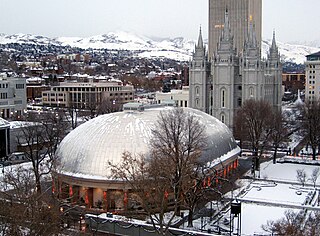
The Salt Lake Tabernacle, formerly known as the Mormon Tabernacle, is located on Temple Square in Salt Lake City, in the U.S. state of Utah. The Tabernacle was built from 1863 to 1875 to house meetings for the Church of Jesus Christ of Latter-day Saints. It was the location of the church's semi-annual general conference until the meeting was moved to the new and larger LDS Conference Center in 2000. Now a historic building on Temple Square, the Salt Lake Tabernacle is still used for overflow crowds during general conference. It is renowned for its remarkable acoustics and iconic pipe organ. The Tabernacle Choir has performed there for over 100 years.

Music & the Spoken Word is a religious radio and television series. Broadcast weekly from the Salt Lake Tabernacle in Salt Lake City, Utah, the program primarily features performances of music by Tabernacle Choir (Choir)—often accompanied by the Salt Lake Tabernacle organ and the Orchestra at Temple Square. The program also includes spiritual messages and passages related to a specific episode's theme, presented by Derrick Porter.
Mathias Peter Møller, commonly known as M.P. Möller or Moeller, was a prolific pipe-organ builder and businessman. A native of the Danish island of Bornholm, he emigrated to the United States in 1872 and founded the M.P. Moller Pipe Organ Company in Greencastle, Pennsylvania, in 1875. The city of Hagerstown, Maryland, took notice of Möller's early successes and induced him to move his business there in 1881 to help make it a viable business center in Western Maryland. The company remained in business in Hagerstown until 1992, with hundreds of employees at its peak and a lifetime production of over 12,000 instruments.

The Joseph Smith Memorial Building (JSMB), originally called the Hotel Utah, is a social center located on the corner of Main Street and South Temple in Salt Lake City. It is named in honor of Joseph Smith, founder of the Latter Day Saint movement. It previously housed several restaurants and also functioned as a venue for events, although it was closed in 2023 for extensive renovations, expected to be completed in 2025. Several levels of the building have also been administrative offices for departments of the Church of Jesus Christ of Latter-day Saints, such as FamilySearch. On January 3, 1978, it was added to the National Register of Historic Places as the Hotel Utah.
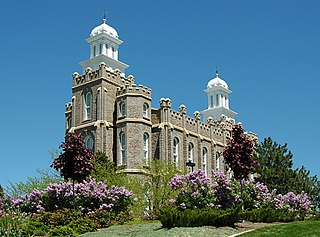
The Logan Utah Temple is a temple of the Church of Jesus Christ of Latter-day Saints. It was completed in 1884 and is the fourth temple built by the church. Located in the city of Logan, Utah, it was the second temple in Utah, after the St. George Temple. It was built on a 9-acre (3.6 ha) plot selected by church president Brigham Young.

The Ogden Utah Temple is the sixteenth constructed and fourteenth operating temple of the Church of Jesus Christ of Latter-day Saints. Located in Ogden, Utah, it was originally built with a modern, single-spire design, similar to the Provo Utah Temple. The temples in Ogden and Provo were designed to be sister temples and are the only ones dedicated by church president Joseph Fielding Smith. The temple became the church’s fifth in Utah, and second along the Wasatch Front, dedicated almost 79 years after the Salt Lake Temple. It was the first to be dedicated in the state of Utah, as the previous ones were dedicated when Utah was still a territory.

The Cathedral Basilica of Christ the King is a Roman Catholic church in Hamilton, Ontario, Canada. The cathedral was consecrated on December 19, 1933. It is the seat of the bishop of the Diocese of Hamilton, and the cathedral of the Diocese of Hamilton. The cathedral contains the cathedra of the bishop, the Most Rev. Douglas Crosby. The cathedral was raised to the status of a minor basilica in February 2013 by Pope Benedict XVI.

Minerva Bernetta Kohlhepp Teichert was a 20th-century American artist who painted Western and Mormon subjects, including murals of scenes from the Book of Mormon. She received her art education from the Art Institute of Chicago and the Art Students League of New York, and was a member of the Church of Jesus Christ of Latter-day Saints. Religious-themed artwork by Teichert includes Christ in a Red Robe, Queen Esther, and Rescue of the Lost Lamb. She painted 42 murals related to stories in the Book of Mormon which reside in Brigham Young University's (BYU) Museum of Art. Teichert was the first woman invited to paint a mural for an LDS Church temple.
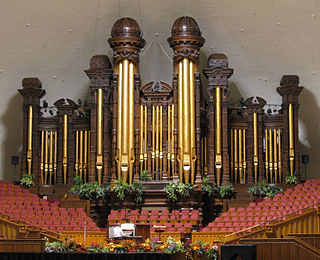
The Salt Lake Tabernacle organ is a pipe organ located in the Salt Lake Tabernacle in Salt Lake City, Utah. Along with the nearby Conference Center organ, it is typically used to accompany the Tabernacle Choir at Temple Square and is also featured in daily noon recitals. It is one of the largest organs in the world. Jack Bethards, president and tonal director of Schoenstein & Co., describes it as an "American classic organ" and "probably one of the most perfect organs ever built."

The Schoenstein Organ at the Conference Center is a pipe organ built by Schoenstein & Co., San Francisco, California located in the Conference Center of the Church of Jesus Christ of Latter-day Saints in Salt Lake City, Utah. The organ was completed in 2003. It is composed of 160 speaking stops spread over five manuals and pedals. Along with the nearby Salt Lake Tabernacle organ, it is typically used to accompany the Tabernacle Choir at Temple Square. Schoenstein & Co.'s president and tonal director, Jack Bethards, describes it as "an American Romantic organ" that is "probably more English than anything else."

The Provo Tabernacle was a tabernacle of the Church of Jesus Christ of Latter-day Saints from 1898 to 2010 in downtown Provo, Utah, United States. It was a historic icon of Provo and had been home to many religious and cultural events. All but the outer walls of the building were destroyed by fire in December 2010. The LDS Church preserved the remaining outer walls and built a new foundation and interior as part of the Provo City Center Temple, completed in 2016.

The current Box Elder Stake Tabernacle, also known as the Brigham City Tabernacle, is a neo-Gothic tabernacle of the Church of Jesus Christ of Latter-day Saints rebuilt in Brigham City, Box Elder County, Utah by Mormon pioneers in 1897 after being gutted by fire a year earlier. The tabernacle continues to function as a meetinghouse for congregants of the Box Elder Stake and seats approximately 1,600. It also hosts concerts and other special events and is open for tours during the summer. Given its unique architecture and importance to the community, the tabernacle was listed on the National Register of Historic Places on May 14, 1971. The temple, built in 2012, stands across from the tabernacle.
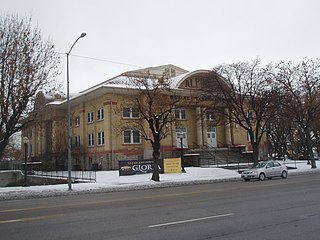
The Alpine Stake Tabernacle or Alpine Tabernacle, located at 110 East Main Street (US-89) in American Fork, Utah, United States, functions as a meeting place for large gatherings of members of the Church of Jesus Christ of Latter-day Saints in northern Utah County for worship services. The building is part of the American Fork Historic District listed on the National Register of Historic Places.
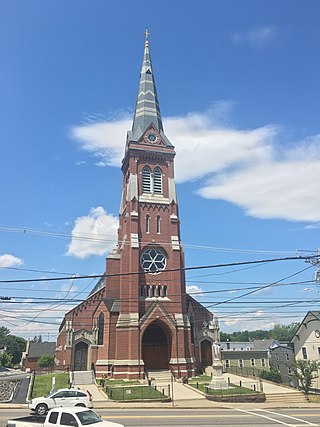
Saint Joseph's Church is one of the 5 churches of Good Shepherd Parish located at 178 Elm Street in Biddeford, Maine. It is also the tallest building in Maine.

The Logan Institute of Religion is the largest institute of religion in the world, and the oldest in Utah. This facility is operated by the Church of Jesus Christ of Latter-day Saints. It is located in Logan, Utah, adjacent to the campus of Utah State University (USU). The institute provides religion classes to young adults aged 18-30, serves as a meetinghouse for local congregations, and sponsors activities for young adults.

The Smithfield Tabernacle is a historic Church of Jesus Christ of Latter-day Saints (LDS) tabernacle and present-day recreation facility in Smithfield, Utah. It is one of 42 surviving LDS tabernacles out of 92 built. The building was a notable construction for a settlement of Smithfield's size, and it served as a geographic and symbolic center for the early town, functioning as an important religious and public space.























